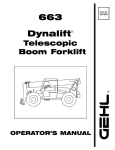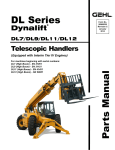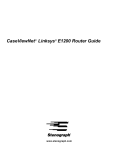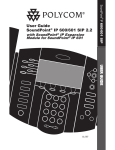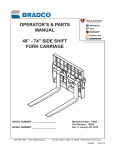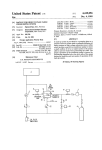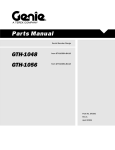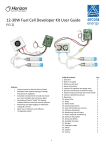Download PDF version - Masonry Construction
Transcript
Forklift maintenance guide Follow proper preventive maintenance procedures to maximize the durability, efficiency, and safety of your telescopic-boom material handlers By Carolyn Schierhorn T ypically costing more than $80,000, a rough-terrain forklift represents a substantial investment to the masonry contractor. To ensure that the material handler performs efficiently for many years, following proper maintenance procedures is essential. At various intervals, a multitude of moving parts must be greased, fluid reservoirs must be replenished, and components must be inspected and replaced if necessary. Adhering to a rigid maintenance schedule will promote machine safety and productivity, as well as minimize costly future repairs. Contractors can save money by doing some repairs themselves. But before servicing a telescopic handler, always consult the operator’s manual to see what parts and systems are still under warranty. Any warranty work must be performed by the dealer or a factory representative. Most rough-terrain forklifts come with a separate engine manual in addition to the operator’s manual. Be sure to read the appropriate manuals prior to doing repair or maintenance work. Not a complete list, the guidelines that follow are general recommendations. All rough-terrain forklifts are not the same. Boom, carriage, and steering system designs vary, so servicing instructions will differ from model to model. And some masonry contractors may prefer to perform Observing daily, weekly, monthly, semiannual, and annual maintenance procedures will help ensure forklift longevity. certain maintenance tasks even more frequently than suggested by the manufacturer. Remember to dispose of all oils and other fluids in accordance with local regulations. Do not pour them on the ground or into a drain. Daily maintenance At the start of every day, the forklift operator should: ■ Check the engine oil, adding more if necessary to maintain the oil level at the full mark on the dipstick ■ Examine the radiator coolant level, first loosening the radiator cap to release system pressure ■ Look at the hydraulic oil level (Many machines have an easyto-read gauge) ■ Grease any fittings and joints designated by the manufacturer for daily lubrication ■ L o o kf o rl o o s e w h e e ln u t s ;t i g h ten anything found loose ■ Check the tire pressure and fill any low tires; if the tires contain calcium chloride and water (hydrofill) for ballast, position the valve stem at the top of the wheel to prevent loss of hydrofill (Ref. 1) ■ Inspect the brake fluid reser- procedures should be scheduled every 500 to 2,000 hours, depending on the task and the manufacturer. The transmission oil, fuel filter, and hydraulic return filter element should be changed approximately every 3 months. Also, examine the muffler and tailpipe then for possible holes; retighten any loose clamps and make sure no gaskets are leaking. The radiator coolant and the hydraulic oil should be replaced every 6 months to a year. If you don’t have a mechanic on staff, t h ed e a l e rc a np e r f o r mt h e s ei mportant tasks. Critical tasks often neglected When a telescopic boom has wear pads, they should be checked on an almost daily basis. voirs and fill them to the proper level ■ After warming up the transmission, check the transmission oil (if appropriate for your machine) At the end of the day, a designated person should: ■ Clean all mud from the accelerator and brake pedals to prevent them from sticking ■ Remove any mud from around wheels and other moving parts; freezing mud could tear off brake lines or hydraulic lines ■ Lower the boom ■ Fill the fuel tank to prevent water from condensing in it ■ In cold weather, cover the machine with a tarp to keep freezing rain and snow from linkage and gauges (Ref. 2) Weekly and monthly tasks Manufacturers have different recommendations as to what preventive maintenance tasks should be performed weekly, every two weeks, and monthly. Most suggest that the air filter be examined weekly. If extremely dirty, it can be washed with water or cleaned with low-pressure compressed air. Replace the air filter element if it has holes or tears. The alternator/fan belt should also be inspected weekly for tension and wear. With your thumb, press the belt down at the center of the longest span and measure the deflection. Replace a belt that has cuts or shows other signs of wear. The engine oil and filter should b ec h a n g e de v e r y 1 0 0t o2 5 0h o u r s , in accordance with manufacturer’s instructions. Follow specifications in the engine manual for the type of filter and the type and viscosity of oil to put in. Change the transmission filter monthly, whenchecking t h et r a nsmission oil level (if used by your forklift). Every month, you also should replace the fuel filter. Check it for water; if water is found, drain the tank. Longer intervals Severalimportant maintenance Although every new forklift comes with an operator’s manual filled with servicing procedures, schedules, and warnings, many contractors n e g l e c tm a c h i n em a i ntenance. Small contractors without mechanics on staff are especiallyguilty, forkliftdealersconcur. And rented or leased forklifts are particularly vulnerable. “Everything gets ignored,” contends Keith Castle of Jerry Castle & Son Hi-Lift Inc. in Elk Grove Village, Ill. “Some contractors just know how to put gas in it—and that’s it. T h e yd o n ’t grease the machine. They don’t change the oil regularly.” Except for large contractors with good record-keeping systems, “contractors, in general, leave a lot of room for improvement,” agrees Ralph Winkler, co-owner and sales manager of Lincoln Contractors Supply in Milwaukee. “I wouldn’t rely on your average operator to even grease the machine,” adds Wayne Morris of Gold Coast Aerial Lift in Hollywood, Fla. “When we rent out machines, we ask customers to perform certain daily maintenance tasks—to check the oil and make sure they don’t run out of fuel. But we don’t rely on them to do the routine scheduled maintenance. Even if they said they’d do it, we wouldn’t take their word for it.” Certain procedures are prone to be neglected. For example, contractors often don’t make sure that tire pressure is checked daily and the tires filled to the pressure level indicated by the manufacturer. “This is very important for stability,” Winkler says. “If you’ve got one front tire with less pressure in it than the other, the machine is off balance.” Because forklifts inevitably run over all manner of jobsite debris, tires will get cut and punctured from time to time; so knowing how to repair a tire is an essential skill. While this shouldn’t be difficult, some of the tires used on rough-terrain forklifts contain calcium chloride or foam, which complicates the procedure. “Often someone will fix the flat but fail to replace the calcium,” observes Garth Landefeld of Metroquip Inc., a Minneapolis forklift dealer. When a foam-filled tire is cut, the operator may underestimate the damage if leakage isn’t apparent. “If the machine is supporting a substantial load while the cut is on the tire bottom, the foam can be pushed out,” Landefeld points out. According to one manufacturer, the most common oversight is failure to check the wear pads on the boom (Not all booms have wear pads, however). Wear pads should be checked almost daily to make sure they’re in place; weekly, they should be adjusted if necessary, notes this manufacturer’s training specialist. “But the wear pads are seldom looked after,” he says. “Sometimes they fall out and no one notices, or they get worn down to the point where they’re nonexistent; yet the contractor continues to operate the machine.” If wear pads aren’t present, the hoses in the boom could rub together and eventually jam. In addition, a forklift’s hydraulic system requires more atten- t i o nt h a ni tu s u a l l yr e c e i v e s .W h e n contractors carelessly store and handle fresh oil, it may become contaminated with dirt and water. Oil contamination causes most of the failures and wear problems in the hydraulic system by shortening the life of components, especially rolling and sliding bearings, gears, and hydrau- Examine the air filter at least weekly; replace it if damaged. lic pumps and cartridges (Ref.1). Landefeld observes that forklifts are commonly abused in the field. Often operators don’t follow the load charts. For example, with the boom extended upward and forward, they will carry a load weighing the forklift’s maximum load capacity. Putting too great a load on the forklift can damage the boom, Landefeld says. “You might bend a slide or cause damage to the front nose where the forks hook up.” Some operators also push with the boom, which can damage the telescopic cylinder or the point where the boom pivots on the frame. Tires are victims of abuse as well as neglect, Morris emphasizes. “We see a lot of negligence on tires, and we charge rental customers for that. It’s an avoidable type of carelessness. Contractors need to keep the jobsite freer of debris, and select paths for the forklift to travel on. I’ve seen operators drive over scrap heaps and destroy tires.” Forklift dealers agree that these problems boil down to lack of operator training and accountability. Frequently, especially at small masonry firms, a forklift won’t have an assigned operator; so no one is responsible for looking after the machine. As a result, according to one manufacturer, “small leaks become big leaks, and loose hardware develops into a major problem.” Training Operator training should be emphasized, whatever the contractor’s size. At a large firm such as Dallas-based Dee Brown Inc., which owns about 20 rough-terrain forklifts, the staff mechanic can train the operators on proper maintenance. James Bunch, Dee Brown’s head mechanic, organizes a half-day operators’ meeting on maintenance once a year. “We go over everything with them —all the preventive maintenance procedures.” Bob Lee of Lee Masonry Inc. in Nashville, Tenn., takes advantage of training provided by the dealer and manufacturer. “The manufacturer of our forklifts has people who will come here locally and put on a training program— a half day on maintenance and a half day on safety. They’ll show you what you should be doing and how to do it.” Assigning responsibility Lee assigns each operator responsibility for a specific forklift, although sometimes the operator may need to drive a different machine. “We say, ‘This is your machine; wherever it goes, you go; you’re responsible for it. If we find abuse problems or lack of maintenance, you’re not going to like the conversation.’ ” At Lee Masonry, “on all of our equipment, we expect our operators to perform the maintenance that is normal and not extraordinary,” says Lee. Operators are responsible for checking the fluid levels, greasing the joints and the boom, changing the engine oil, and cleaning and replacing the filters. The foremen must make sure the maintenance procedures are carried out, but it’s not their responsibilitytoperformthetasks. Lee Masonry documents preventive maintenance in weekly reports. Documentation is very important because a manufacturer may be able to void a particular warranty if proper maintenance hasn’t been performed. Establishing an efficient routine Once operators get used to doing maintenance, it doesn’t take much time, Lee observes. “Each morning, they’ve got about 10 minutes worth of tasks to do when they start up. In that period, they’ll apply two squirts of grease to each one of the fittings. They’ll check all the liquids very quickly. For example, they’ll just flip the radiator cap and observe,‘Yes, it’s got fluid in it.’ They’ll pull the oil d i p s t i c ka n dc h e c ki t .T h e y ’ l lc h e c k the battery water. In most of our machines, we can see the hydraulic level without doing anything but glancing at the gauge.” Weekly maintenance procedures at Lee Masonry take about an hour on Friday afternoon; but some operators begin those tasks on Thursday to get a head start. Repairs and major maintenance Large contracting firms such as Dee Brown often prefer to do their own repairs. “I take care of all repairs and major servicing,” says Bunch. “We don’t send anything out.” Lee takes a different approach, though. “We are fairly strong believers that you’re better off getting equipment serviced by the factory representative.” While operators will grease the slide plates in a boom, “they can’t replace them,” Lee says. “Those are items we’ll have serviced by the dealer, and it varies with the machine whether it’s every 2,000 or 3,000 hours. Additionally, at that time, the dealer will do what the operator does once a week or more often to make sure it’s being done properly. The dealer also will send oils out to be tested for signs of abnormal wear.” Maintenance should influence purchase decision Ease of maintenance should be a consideration when purchasing a forklift. How accessible are the fluids and components that need to be cleaned or replaced periodically? Are the fluid levels, such as the hydraulic oil, indicated by easy-to-read gauges? Can you understand the operator’s manual? Does the manufacturer or dealer offer maintenance training? Also, consider limiting your firm to rough-terrain forklifts produced by one manufacturer. Lee prefers to buy the same type of forklift when he can because there are significant differences among brands—for example, twowheel vs. four-wheel steering, 90degree pivot-type turning vs. a traversing carriage. “We try to standardize as much as possible, so we know the maintenance is pretty much the same on every one of these machines except for minor differences in models,” Lee says. Whether your firm is large or small, whether you rely on a staff mechanic or dealer support, your telescopichandlers deserveconsiderable attention. A thorough preventive maintenance program will maximize your forklift’s life, your operator’s safety, and your satisfaction with the investment. References 1. “Rough-terrain Forklift Maintenance Tips,” Trak International Inc., 369 W. Western Ave., Port Washington, WI 53074. 2. “Maintenance Tips,” Jerry Castle & Sons Hi-Lift Inc., 651 E. Devon, Elk Grove Village, IL 60007. 3. Dynalift Series, Telescoping Boom Forklift Operator’s Manual, 1994, Gehl Co., P.O. Box 179, West Bend, WI 53095. 4. Operation & Lubrication Manual, 1994, The Gradall Co., 405 Mill Ave. S.W., New Philadelphia, OH 44663. 5. Owner/Operator Manual, Traverse Lift Co., P.O. Box 451960, Houston, TX 77245. 6. Pettibone Extendo Service Manual, Pettibone Michigan, P.O. Box 368, Baraga, MI 49908. 7. Sky Trak Owners/Operators Manual, 1995, Trak International. 8. Square Shooter Operator’s Manual, Baraga Products Inc., P.O. Box 248, Baraga, MI 49908. PUBLICATION #M950384 Copyright © 1995, The Aberdeen Group All rights reserved




